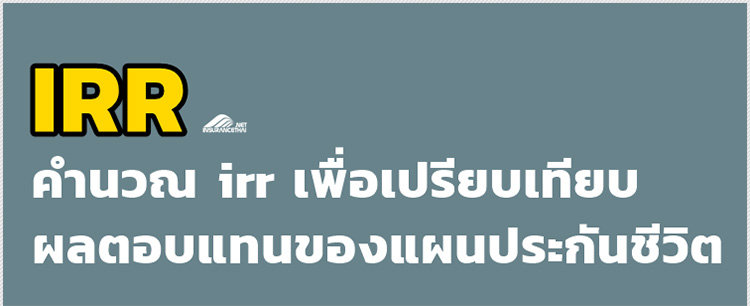เปรียบเทียบประกันแบบ Term,Whole Life,Saving
เปรียบเทียบประกัน แบบ Term, Whole Life และ Saving
ประกันประกัน แบบ Term (แบบชั่วระยะเวลา)
ประกันประกัน แบบ Whole Life (แบบตลอดชีพ)
ประกันประกัน แบบ Saving (แบบสะสมทรัพย์)
เปรียบเทียบแบบประกันทั้ง 3 แบบ ว่ามีเบี้ยประกันและผลประโยชน์แตกต่างกันอย่างไร !!
เเล้วทำไมเราจึงไม่ควรเน้นการใช้ประกันชีวิตเป็นเครื่องมือในการลงทุน!!
อย่างไรก็ตาม หากจะมาคุยกันถึงเรื่องปัญหาของการเก็บเงิน แท้จริงไม่ใช่ตัวของ “ผลตอบแทน” เเต่เป็นเรื่องของ “ระบบการเก็บ”
เนื่องจากปัญหาที่คนส่วนใหญ่เก็บเงินไม่ได้นั้น มาจาก การไม่ได้เก็บเงินมากกว่า
ตัวอย่าง
หากเราออมเงินเอง ฝากธนาคาร ด้วยการที่ธนาคารนั้นเราสามารถถอนและฝากได้ตลอด โดยทั่วไปคนจะถอนออกมาก่อนเพื่อซื้อนั่นนี่
แต่หากนำเงินดังกล่าวไปฝากแบบประกัน(ซึ่งถอนได้ยาก)สุดท้ายจะมีเงินเก็บ
หรือแม้กระทั่ง เอาเงินไปทิ้งที่สระน้ำ หรือ ฝั่งไว้ในไห แบบสม่ำเสมอ เมื่อ 10ปีผ่านไปมาดู แม้มันจะไม่มีดอกเบี้ยเเต่ก็มีเงินเก็บ
แต่หากเราสามารถเอาชนะใตัวเองได้ มีวินัยการเก็บเงินที่ดีมากๆ ก็สามารถเลือกการลงทุนที่ให้ผลตอบเเทนสูงกว่าได้
อย่าลืมว่า โดยเนื้อแท้ของประกันชีวิตแล้วคือ การคุ้มครอง ส่วนเรื่องการเก็บเงิน การรักษาพยาบาลนั้นเป็นเพียงผลประโยชน์ที่เพิ่มเข้ามานั่นเอง
Compare Term Life Insurance vs. Whole Life Insurance Rates on our website now. Life insurance doesn’t have to be complicated. Term life insurance definition – it pays the face amount of the policy, but only provides protection for a limited amount of time. Here’s a good term life insurance definition, check out this article on Wiki.
Whole policies carry a cash value but the premiums are usually level for the life of the insured. Compare term life insurance rates vs. whole life insurance rates now.
The more common types of exclusions are for hazardous occupations, hazardous hobbies or other undertakings. Riders may be attached to policies to exclude specific risks. Also generally excluded is coverage for death resulting from war, the commission of a felony or death by suicide (for a limited period), as discussed previously. Term life insurance comparison is made easier now – enter your zip to get free quotes.
Some aviation risks are excluded and some are not excluded. Today, flights as fare-paying passengers on regularly scheduled airlines are not sufficiently hazardous to affect the risk, so most policies cover insureds on commercial flights. However, if insurance applicants are involved as pilots or crew members in commercial, military or private flying, they usually are asked to submit complete aviation questionnaires to provide specific and detailed information. Commercial pilots and crew members flying on regularly scheduled flights generally are insured at standard rates. Private pilots who meet specific standards also may be covered without restrictions.
In other cases, the company may decide the added aviation risk is too great and either charge an extra premium to compensate for the extra hazard or exclude the specific risk from the policy. If an aviation risk is excluded and the insured dies as the result of that activity, the company’s liability generally is limited to a return of premium or paying out the reserves accumulated in the policy.
Also, double indemnity coverage usually will not be granted to persons participating in aviation activities, except when riding as passengers on commercial airline flights.
Term Life Insurance Comparison
Term life insurance comparison only take minutes online. Years ago, legislative measures modeled after the Standard Nonforfeiture Law were adopted by most states to protect policyowners against the loss of their cash values in permanent life insurance. The cash values in life insurance policies were deemed the personal assets of policyowners, as the cash values are created under the level premium system. Under that system, premiums paid in the early policy years are higher than needed in order to compensate for later policy years when much higher premiums otherwise would be payable. Thus, cash values build up during the life of a permanent life insurance contract.
In essence, the nonforfeiture values represent the equity of policyowners in their policies; therefore, those values are available to policyowners in the event their policies are terminated other than by death.
The nonforfeiture options provide policyowners with the privilege to elect any one of three separate options, if or when the policyowners decide to stop paying premiums on their policies. The options are:
1. taking the policy’s cash surrender value as a lump-sum cash payment;
2. using the cash value to buy paid-up insurance; and
3. using the cash value to buy extended term insurance.
Find out if whole life insurance might be a good choice for you.










